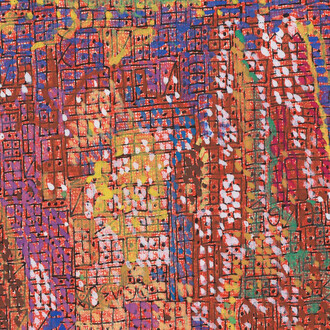Kalfayan Galleries (11 Haritos Street, Kolonaki, Athens) present a solo exhibition of Vlassis Caniaris’ (1928 – 2011) work, which sheds further light on the multifaceted artistic practice of the artist, one of the most significant of the post-war period in Greece. Wellknown for his socio-political concerns, which are reflected in his ‘Gastarbeiter- Fremdarbeiter’ (‘Guest workers – Foreign Workers’) series from the mid-970s, the artist focused on the lives and living conditions of emigrants living in Germany at the time.
In 2009, two years before his death, the artist presented for the first time in Athens at Kalfayan Galleries, his monumental installation titled ‘Arrivederci-Willkommen-1976’ which was featured in 2014 at the Gwangju Biennale (curated by Jessica Morgan) and will be shown at the Manège de Sury in Mons, Belgium in the exhibition ‘Atopolis’ being organized by the Wiels Centre d’Art Contemporain in Brussels. In 2012, Kalfayan Galleries presented a second solo show with Caniaris’ landmark installation titled “Cocktail”.
The current show, which marks the third solo presentation of the artist’s work at Kalfayan Galleries, features, among individual free-standing works and wall pieces, monumental installations such as the ‘Tourist’ and the ‘What’s North, What’s South (Children and Testimony)’. The latter was presented at 1988 at the Venice Biennale.
Always a keen observer of his surroundings but also of the world at large, Caniaris' iconography has always concerned itself with socio-political themes. He was one of the most significant artists of the post-war period and helped contribute to the creation of a new artistic climate in post-war Greece. He belongs to the generation of Greek artists who worked in Italy, France and Germany during the ‘60s and ‘70s when he developed a personal distinctive style, experimenting with modes of expression that strayed from the mainstream.
With echoes of Arte Povera and the trends that had developed since Marcel Duchamp, Caniaris began to use found objects in his works in the early 1960s and the human figure gradually began to enter his thematic explorations. The first ‘environments’ were created in 1971 as he turned his attention fully on the problem of the influx of economic emigrants in Germany. In these works, the artist included all the ordinary objects that people acquire and use to shape their lives –chairs and toys, bicycles and suitcases- attempting through personal observation to reconstruct individual histories, dreams and realities, the burden of economic hardship.
In 1988, Caniaris, together with Nikos Kessanlis, represented Greece at the Venice Biennale and in 1997 his work was exhibited at Documenta. His work has been exhibited widely in museums and galleries throughout Greece, Europe and in the United States. His work can be found in numerous museum collections including the Tate Modern in London, the Museum am Ostwall Dortmund and in many important private collections.
Vlassis Caniaris was born in Athens in 1928, where he died in 2011. From 1956 to 1960 he lived and studied in Rome and then settled in Paris until 1971. From 1973 to 1975 he lived in Berlin and then returned to Athens where he lived and worked until his death. He studied at the Athens School of Fine Arts (1950-1955),The School of Fine Arts, Rome (1959) and the University of Athens, School of Medicine (1946-1950). In 1976 he was elected to the chair in Architecture at the National Technical University in Athens and remained until 1996. His work has been exhibited in major museums and galleries worldwide, and most recently at the 10th Gwangu Biennale (2014). Upcoming show will be held at Wiels Centre d’Art Contemporain in Brussels. In 1988, together with Nikos Kessanlis, he represented Greece at the Venice Biennale and in 1997 his work was shown at Documenta. Caniaris has widely exhibited in museums and galleries throughout Europe and the United States. His work can be found in numerous private and museum collections as well as the Tate Modern in London, the Ludwig Collection and Museum am Ostwall Dortmund.
The Gallery will be closed for Easter holidays: 9 – 14 April 2015
















